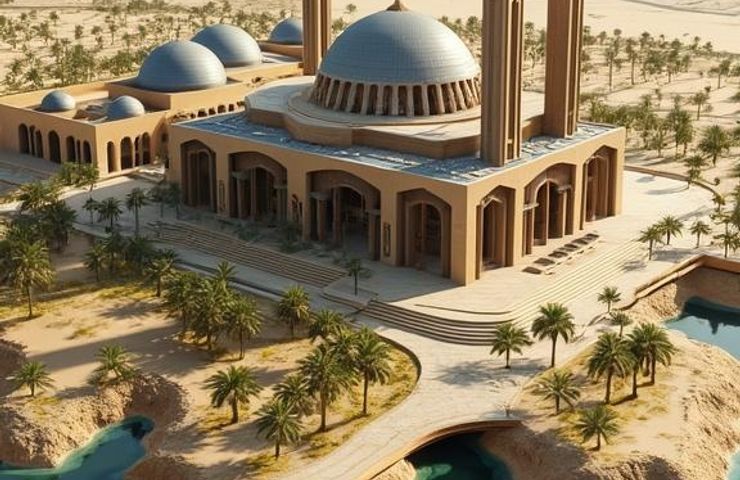
Hydrogen Production Drives Green Steel for Abu Dhabi’s First Net-Zero Mosque
August 27, 2025EMSTEEL has teamed up with Aldar Properties and Masdar to roll out the MENA region’s first-ever hydrogen-based steel rebar for Abu Dhabi’s debut net-zero carbon mosque in Masdar City’s Sustainable District on Yas Island. This 1,595 sqm sanctuary, designed to welcome over 1,300 worshippers, sits at the heart of a masterplan for smart, low-carbon urban communities. This delivery not only pushes the mosque closer to its goal of LEED Zero Carbon certification but also shines a light on the power of public-private teamwork and the UAE’s fast-track sprint toward its 2050 net-zero targets and broader sustainable energy goals.
Key Insights
- This project is the first big-scale application of green hydrogen in steelmaking across the region, chopping CO₂ emissions by up to 95% compared to traditional blast furnaces.
- Back in October 2024, EMSTEEL and Masdar ran a pilot that churned out 5,000 tonnes of certified green steel, proving the concept works at scale.
- Aldar Properties earns bragging rights as the region’s first developer to use hydrogen-based steel in a landmark building.
- The mosque’s design leans on thick rammed earth walls, passive cooling, solar panels, low-carbon concrete, and energy-efficient LED lighting to serve over 1,300 visitors across 1,595 sqm.
- Avance Labs and Bureau Veritas independently stamped the steel with global sustainability certifications, making sure it ticks all the right boxes.
- This effort revs up the UAE’s industrial decarbonization playbook, eyeing a 40% emissions drop by 2030 on the road to net-zero by 2050.
Green Hydrogen and Steel: A Closer Look
At the core of this milestone is green hydrogen-fueled steelmaking. In that October 2024 pilot, Masdar’s renewable-powered electrolyzers whipped up hydrogen that replaced natural gas and coal for direct iron ore reduction. Thanks to this hydrogen production route, sponge iron emerges with nothing but water vapor as a byproduct, slashing carbon emissions by about 95% over standard blast furnace methods. That same process cranked out 5,000 tonnes of green steel for the mosque, all independently verified by Avance Labs and Bureau Veritas against international low-emission benchmarks.
What’s more, the whole setup taps into Masdar City’s solar and wind microgrid, ensuring the electrolytic hydrogen—and ultimately the rebar—carries almost zero embedded carbon. After the reduction stage, the sponge iron gets melted, alloyed, and transformed into rebar under tight quality controls. Over at EMSTEEL’s Fujairah plant, the bars are rolled, cooled, and prepped for delivery, showing how top-notch zero-emission technology can slide right into conventional supply lines without skimping on strength or breaking the bank.
EMSTEEL isn’t stopping here. Their roadmap calls for cranking up green steel output to 100,000 tonnes a year by 2030, setting the stage for a fully net-zero production line by 2050. Hitting those targets means adding more electrolyzers, signing up fresh renewable power deals, and fine-tuning every step of the process. Early numbers hint that, once you scale up, green hydrogen could dip below $1.50/kg, making the whole approach not just eco-friendly but also commercially sustainable—ready to roll out beyond headline projects like this mosque.
Designing the Net-Zero Mosque
The mosque’s look is all about blending time-honored Islamic architecture with next-gen sustainability. Those hefty rammed earth walls, crafted from local soil, give the space thermal mass that keeps indoor temps steady in Abu Dhabi’s heat. Combined with passive cooling vents and courtyards strategically placed for natural airflow, they slash HVAC energy use by over 35%. Up top, solar panels generate a hefty chunk of the mosque’s power needs, running LED lights, efficient water pumps, and even the ablution stations.
Spanning 1,595 sqm and built for more than 1,300 worshippers, the design also calls for low-carbon concrete mixes and ethically sourced carpets. Every fixture and finish gets scrutinized for low embodied emissions, while the hydrogen-based rebar ties it all together to meet the strictest LEED Zero Carbon standards. The result? A public building that’s both spiritually uplifting and a showcase for next-level sustainable energy design.
Strategic Partnership and Market Implications
EMSTEEL, Aldar Properties, and Masdar have stitched together a partnership that fast-tracks low-carbon materials at scale. For EMSTEEL, the mosque is a live demo of their green steel credentials, amping up investor confidence as they eye future listings. Aldar, already a trailblazer for hydrogen-based steel, cements its green-building reputation and optimizes its supply chain. Masdar, with its mix of solar farms and wind assets, anchors the entire setup, proving how an integrated renewable energy portfolio can power heavy industry.
On top of that, the project highlights why smart policy matters. The UAE’s Net Zero by 2050 strategy, alongside incentives for green construction, has created fertile ground for innovation. As carbon disclosure becomes a must for big developments, early movers like this trio can tap into green finance at attractive rates, tipping the scales in favor of sustainable materials.
Regional Impact and Future Steps
This net-zero mosque isn’t just a standalone win; it’s a springboard for regional industrial decarbonization. By showing there’s a clear playbook for both making and using green steel, it takes the fear out of the unknown for other players thinking about green hydrogen and zero-emission building materials. Workshops are already on the calendar for late 2025, where engineers, architects, and procurement teams from across the GCC can learn the ropes. Plans are also afoot to boost electrolyzer capacity past 50 MW, fueled by green bonds and public-private funding.
Saudi Arabia, Qatar, and other neighbors are watching closely. If this mosque checks all the boxes, it could spur new regional standards for low-emission building codes and even shape carbon credit markets linked to sustainable materials. Lenders and investors are tracking the project’s numbers, ready to back the next wave of zero-emission technology ventures.
Outlook
We’re at a real crossroads where green hydrogen meets centuries-old craftsmanship. This mosque proves you don’t have to choose between heritage and climate action. As the UAE marches toward its 2050 net-zero goals, projects like this will set the pace for mainstreaming hydrogen-based steel and other clean materials. And if costs keep sliding and regulations stay supportive, we could soon see zero-emission technology popping up in construction projects all around the Middle East—and beyond.



 With over 15 years of reporting hydrogen news, we are your premier source for the latest updates and insights in hydrogen and renewable energy.
With over 15 years of reporting hydrogen news, we are your premier source for the latest updates and insights in hydrogen and renewable energy.